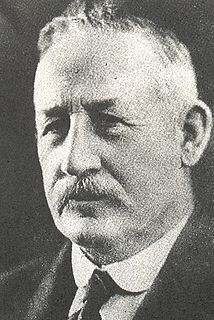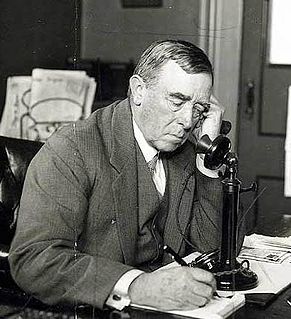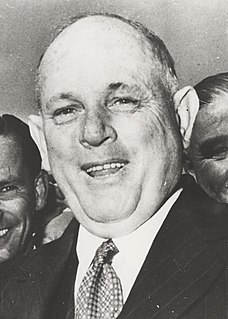
John Cain was an Australian politician, who became the 34th premier of Victoria, and was the first Labor Party leader to win a majority in the Victorian Legislative Assembly. He is the only premier of Victoria to date whose son has also served as premier.
Ian Macfarlan was the Deputy Leader of the Australian Liberal Party in the Australian state of Victoria during 1945. He was briefly commissioned as the 35th Premier of Victoria by the Governor and formed a government which brought about the end of the Dunstan Ministry.

John Allan, Australian politician, was the 29th Premier of Victoria. He was born near Lancefield, where his father was a farmer of Scottish origin, and educated at state schools. He took up wheat and dairy farming at Wyuna and was director of a butter factory at Kyabram. In 1892 he married Annie Stewart, with whom he had six children.

Edmond John "Ned" Hogan was an Australian politician who was the 30th Premier of Victoria. He was born in Wallace, Victoria, where his Irish-born parents were small farmers. After attending a Roman Catholic primary school, he became a farm worker and then a timber worker, and spent some time on the goldfields of Western Australia.
The following lists events that happened during 1935 in Australia.

Sir Stanley Seymour Argyle KBE, Australian politician, was the 32nd Premier of Victoria.
This is a list of members of the Victorian Legislative Assembly from 1935 to 1937, as elected at the 1935 state election.
This is a list of members of the Victorian Legislative Assembly from 1943 to 1945, as elected at the 1943 state election.
The First Cain Ministry was the 50th ministry of the Government of Victoria (Australia). It was led by the Premier of Victoria, John Cain of the Labour Party. The ministry was sworn in on 14 September 1943, but lasted less than four days. On 15 September, barely 24 hours after Governor of Victoria Sir Winston Dugan had sworn-in the cabinet, the government was defeated in the Legislative Assembly. Cain's motion to adjourn the parliament for over a week was defeated by the Country Party and the UAP, and Opposition Leader, Albert Dunstan, moved that Parliament resume the next day, giving notice that he would move a motion of no confidence against Cain's government, confident it would be carried by the CP–UAP alliance. Cain indicated that he would request a dissolution of parliament from the Governor, but if his request was refused, he would resign as Premier. On 17 September, Cain visited the Governor who refused his request for a dissolution—Cain then resigned and the Governor commissioned Dunstan to form a government, which was sworn in on Saturday 18 September.
The Second Dunstan Ministry was the 51st ministry of the Government of Victoria. It was led by the Premier of Victoria, Albert Dunstan. The ministry was sworn in on 18 September 1943, just several days after the formation of the First Cain Ministry, and consisted of members of the Country Party and the United Australia Party (UAP).
Thomas Tunnecliffe was an Australian politician. He was a member of the Victorian Legislative Assembly, representing the districts of West Melbourne (1903–1904), Eaglehawk (1907–1920) and Collingwood (1921–1947) for the Labor Party.

The 1950 Victorian state election was held in the Australian state of Victoria on Saturday 13 May 1950 to elect 65 members of the state's Legislative Assembly.

George Hamilton Lamb was an Australian politician. He was a member of the Victorian Legislative Assembly from 1935 until his death in 1943, representing the electorate of Lowan for the Country Party.

The 1935 Victorian state election was held in the Australian state of Victoria on Saturday 2 March 1935 to elect 53 of the 65 members of the state's Legislative Assembly. 12 seats were uncontested.
Sir John Herman (Henry) Lienhop was an Australian politician and grazier. He was the member of the Victorian Legislative Council for Bendigo Province from June 1937 to February 1951.

The National Party of Australia – Victoria is a political party in Victoria, which forms the state branch of the federal Nationals. Traditionally representing graziers, farmers and rural voters generally. The Victorian Farmer's Union formed in 1914 was the precursor to the Victorian Country Party, later the Nationals.
Edwin Joseph Mackrell was an Australian politician.
Sir Albert Louis (Lou) Bussau was an Australian politician.
The Australian Labor Party , also known as Victorian Labor, is the semi-autonomous Victorian branch of the Australian Labor Party (ALP). The Victorian branch comprises two major wings: the parliamentary wing and the organisational wing. The parliamentary wing comprising all elected party members in the Legislative Assembly and Legislative Council, which when they meet collectively constitute the party caucus. The parliamentary leader is elected from and by the caucus, and party factions have a strong influence in the election of the leader. The leader's position is dependent on the continuing support of the caucus and the leader may be deposed by failing to win a vote of confidence of parliamentary members. By convention, the premier sits in the Legislative Assembly, and is the leader of the party controlling a majority in that house. The party leader also typically is a member of the Assembly, though this is not a strict party constitutional requirement.









